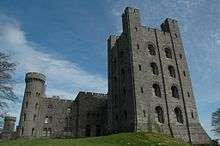Thomas Hopper (architect)
| Thomas Hopper | |
|---|---|
| Born | 1776 |
| Died | 1856 |
| Occupation | Architect |
| Known for | country houses across southern England |
Thomas Hopper (1776–1856) was an English architect of the late 18th and early 19th centuries, much favoured by King George IV, and particularly notable for his work on country houses across southern England, with occasional forays further afield, into Wales and Northern Ireland. He was involved with improvements to the Shire Hall in Monmouth under "Royal assent" where he and Edward Haycock made the building extend down Agincourt Street creating room for a new staircase and larger courts. Hopper took up residence in Monnow Street in Monmouth whilst this was happening.[1]
In 1840 he exhibited designs for Butterton Hall in Staffordshire. This gothic building lasted until the first World War when it was demolished due to misuse during the war.[2]
Hopper died in 1856.[2]
Projects
- Leigh Court, north Somerset (1814)[3]
- Penrhyn Castle, Llandegai, Bangor, north Wales (1822–1837)[4]
- Kentwell Hall, Suffolk (1820s)
- Arthur’s Club, 69–70 St James’s Street, London (after 1940 the Carlton) (1826–7)
- Llanover House, Abergavenny, Wales (1827–1837; demolished 1935)
- Improvements to the Shire Hall, Monmouth (1829)[1]
- Bryn Bras Castle, Llanrug north Wales (1829–1835)[5]
- Margam Castle, south Wales (1830–1840)
- Wivenhoe House, Essex (1846–53)
- Hospital buildings at St Mary's Hospital, Paddington, London (1851)
- Alscot Park, Warwickshire
- Amesbury Abbey, Wiltshire
- Boreham House, Essex
- Gothic Conservatory at Carlton House, London, demolished
- Crichel House, Dorset, alterations
- Danbury Place, Essex
- Easton Lodge, Essex
- Englefield House, Berkshire
- Gosford Castle, County Armagh
- Chapel at Stansted Park, West Sussex
- Glemham House, Suffolk (1814)
- Terling Place, Essex
- Works at Windsor Castle
- Gothic Ballroom at Slane Castle, County Meath, Ireland
- Entrance lodge at Dromoland Castle, County Clare, Ireland
- Woolverstone Hall, Suffolk (extension and remodelling)
Gallery of architectural works
 Penrhyn Castle, south front
Penrhyn Castle, south front Penrhyn Castle, south front
Penrhyn Castle, south front Penrhyn Castle, centre of west front
Penrhyn Castle, centre of west front Penrhyn Castle, east front
Penrhyn Castle, east front The Drawing Room, Leigh Court
The Drawing Room, Leigh Court The Conservatory exterior, Carlton House, London
The Conservatory exterior, Carlton House, London The Conservatory interior, Carlton House, London
The Conservatory interior, Carlton House, London Garden front, Margam Castle
Garden front, Margam Castle West front, Margam Castle
West front, Margam Castle Lantern above main staircase, Margam Castle
Lantern above main staircase, Margam Castle Main staircase, Margam Castle
Main staircase, Margam Castle Main staircase, Margam Castle
Main staircase, Margam Castle
References
- 1 2 "History of Shire Hall". Monmouth Shire Hall. Retrieved 8 April 2012.
- 1 2 "Butterton Hall". lost country houses of England.
- ↑ "Leigh Court". Images of England. English Heritage. Retrieved 2012-03-09.
- ↑ Port, M. H. (2004). "Hopper, Thomas (1776–1856)". Oxford Dictionary of National Biography. Oxford University Press. doi:10.1093/ref:odnb/13763. Retrieved 2013-01-23. (subscription or UK public library membership required)
- ↑ "Bryn Bras Castle". Retrieved 2013-01-23.